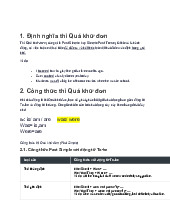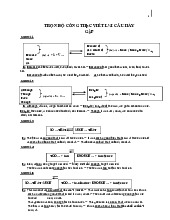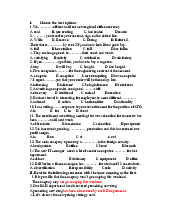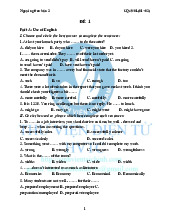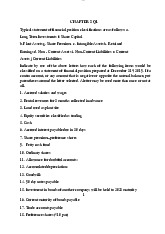










Preview text:
lOMoAR cPSD| 48632119
1. Government-placed restrictions on trade between nations are………
A. Subsidies B. Tariff C. Quota D. Trade barrier
2. The practice of selling foreign imports in the domestic economy at prices lower
than the actual cost of production is called ………….
A. Dumping B. Competing C. Challenging D. Restricting
3. The price of imported good is added with ………….
A. Tariff B. Taxes C. Quotas D. Non-tariffs
4.....................is a good period for sellers, when prices are rising quickly.
A. Price boom B. Price cut C. Price hike D. Price leader
5....................is contributed by shareholders who put up money and hold shares in the company.
A. Capital B. Share capital C. Loan capital D. Leverage
6...................calculates how much tax an individual or a company should pay – or trying to reduce this figure.
A. Financial accounting B. Auditing
C. Tax accounting D. Management accounting
7....................is one of the major financial statements used by accountants and business owners.
A. The income statement B. The ledger
C. The journal D. The accounting balance sheet
8.....................reviews accounting and financial transactions to determine if
commitments, authorization, receipt, and disbursement of funds are properly and
accurately recorded and reported.
A. Operational audit B. Financial audit
C. Compliance audit D. Information systems audit
9......................is a statistical record of all the economic transactions between residents of
the reporting country and residents of the rest of the world during a given time period. lOMoAR cPSD| 48632119
A. The balance of trade B. Barter or counter-trade
C. Merchandise trade D. The balance of payments
10. Most good systems will provide accounting controls against errors, as well as a
division of duties to reduce the possibility of ………….
A. Appropriations B. Misappropriation
C. Disappropriations D. Misappropriations
1. All nation use some kinds of trade barriers (rào cản thương mại) for their own…
A. Interest B. Purposes C. Benefits D. Profits
2..........is an accounting function that involves the review and evaluation of finacial records.
A. Auditing B. Auditor C. Audit D.Internal audit
3..........are used to prevent the import or export of anything with another country.
A. Subsidies B. Tariff C. Quotas D. Embargoes
4. Bookkeeping is a process of detailed of all the financial transactions of a business.
A. Dicusses B. Recording C. Transferring D. Accounting
5. All information contained in this report is. …and remains the property of the company.
A. Evaluation B. Confidential C. Receivable D. Benefit
6. Consumers will get..............of 8% off phone bills from May.
A. Price cut B. Price controls C. Price tag D. Price war
7.......in a marketing mix includes such factors as distribution channels, locations of
points of sale, transport, inventory size, ect.
A. Product B. Price C. Place D. Promotion
8. A tariff increases the price of the item, raise..............for the government and controls
consumption through market force.
A. Quota B. Absolute advantage C. Climate D. Revenue lOMoAR cPSD| 48632119
9. The practice of selling foreign imports in the domestic economy at priceslower than
actual cost of production is called………
A. Dumping B. Competing C. Challenging D. Restricting
10. What is the mean “sum of money owed to customers for goods or services purchased on credit”?
A. Accounts receivable B. Liabilities
C. Turnover D. Accounts payable
1. If a company gains a listing on the …, this will provide the long-term opportunity
of raising capital by issuing fresh shares.
A. Owner’s capital B. Venture capital
C. Unlisted security market D. Stock Exchange
2. The best-known classification of these elements is the “4P”: …, place, promotion and price.
A. Product B. Producer C. Production D. Produce
3. Every company has to prepare … to hand in the tax authority
A. tax report B. tax return C. tax refund D. tax avoidance
4. What is NOT one of six aspects of operating performance and financial
condition we can evaluate from financial ratios?
A. A shareholder ratio B. An activity ratio
C. A profitable ratio D. A turnover ratio
5. Even those companies that do not … an internal audit need to maintain a system of internal control
A. conduct B. control C. guide D. manage
6.In order to import and export products, there needs to be a system of international monetary ….
A. change B. exchange C. changeability D. exchangeable
7. A country with a … account surplus, for example, can use the extra
Money to invest abroad, or it can put it in its cookie jar of foreign currency reserves. lOMoAR cPSD| 48632119
A. Existing B. current C. payment D. present
8. The narrowest measure of a country's trade, the merchandise trade balance, looks only
at "…" goods such as videocassette recorders, wine, and motorcycles.
A. visible B. invisible C. Invincible D. unsighted
9. … can be beneficial to the aggregate domestic economy they tend to be most
beneficial, and thus most commonly promoted by domestic firms facing competition from foreign imports.
A. Trade barriers B. Trade surpluses C.
Trade deficits D. Balance of payments
10.The widest measure of a country's trade is called its ….
A. merchandise trade balance B. the current account C. balance of payments
1. What does corporate finance include?
A. Planning, raising, distributing and investing of finance
B. Planning, raising, investing and monitoring of finance
C. Raising, funding, investing and monitoring of finance
D. Planning, raising, funding and investing of finance
2. Which is one of the most common mistakes in setting the price in many companies?
A. Pricing is partly cost oriented
B. Price is revised often enough to capitalize on market changes
C. Price is set independently of the rest of the marketing mix rather than as an intrinsic
element of market-positioning strategy
D. Price is varied enough forr different product items and market segments
3. What factors are included in promotion?
A. Advertising, discounts, sales promotion and personal selling
B. Product, place, promotion and price
C. Price, advertising, personal selling, publicty lOMoAR cPSD| 48632119
D. Advertising, publicity, sales promotion and personal selling
4. For what purposes isn’t management acounting information used?
A. For setting the company’s overall goals
B. For evaluating the performance of departments and individuals
C. For deciding whether to introduce a new line of products
D. For assisting investors and cresitors in deciding where to place their scarce investment resources
5. Which financial quantities does gearing show the relationship between?
A. Equity capital and short-term debt
B. Equity capital and long-term debt
C. Equity capital and total assets
D. Long-term debt and total assets
6. By construction, ratios can be classified into:
A. Coverage ratio, return ratio, turnover ratio and component percentage
B. Coverage ratio, profitability ratio, turnover ratio, component percentage
C. Liquidity ratio, return ratio, leverage ratio and component percentag
D. Coverage ratio, return ratio, turnover ratio and leverage ratio
7. What weakness exists in the internal auditing system?
A. The internal auditors don’t often identify errors in their financial statements B.
The internal auditors can’t make suggestions to management for improvements in
the standard operating procedures
C. If a report is unfavorable, it may not be shown to the person in management wwho can correct the problem
D. All three answers above are wrong
8. The sources of data being available for financial analysis is: A. Financial statement data
B. Economic data such as the Gross Domestic Product and Consumer Price Index lOMoAR cPSD| 48632119
C. Marrket data such as the market prices of securities off publicly traded corporations D. All of the above
9. What are includes in inventories of company?
A. Raw materials, production tools, working in progress and finished goods
B. Raw materials, working in progress and finished goods
C. Materials, merchandise, finished goods
D. Raw material, wworking in progress and products
10.The price of imported goods is added with:
A. Tariff B. Taxes C. Non-tariffs D. Quotas
1. Another name for the balance sheet is …
A. Statement of operations B. Statement of Finance position
2. Which of the following is an asset account?
A. Accounts payable B. Prepaid Insurance C. Unearned Revenue
3. A company disposes of equipment that it no longer uses in its business. The amout
received by the company is more than the amount the asset is carried at in the accounting
records. The company will report a……
A. Expenses B. Gains C. Loss D. Revenue
4. Net sales minus the Cost of Goods sold equal…………
A. Gross profit B. Income from operations C. Net income
5. Gross Profit minus Operating Expenses is best defined as ……
A. Net income B. Net sales C. Operating income
6. In general, the term "auditors"include
A. CPAs B. Government auditors
C.Internal auditors D. all of the above 7. An auditor must:
A. Be qualified to understand the criteria used lOMoAR cPSD| 48632119
B. Be competent to know the types and amount of evidence
C. Have an independent mental attitude D. All of the above
8. What is the foreign exchange market?
A. The foreign exchange market ib the market in which participants are able to buy, sell,
exchange and speculate on currencies
B. The foreign exchange market is a global decentralized market C. A&B
D. The foreign exchange market is not over-the-counter market
9. What are benefits of foreign exchange market?
A. Increasing liquidity B. Fast transaction
C. Participants always make a profit D. A&C
10. The combination of selling Expenses is best defined as………….
A. General expenses B. Operating expenses C. Total expenses
1..........is when a country's businesses lower the sales price of their exports to unfairly gain market share. A. Competing C. Challenging B. Dumping D. Restricting
2. The current assets section of the balance sheet should include: A. Liabilities C. Goodwill B. Patents D. Inventory
3. A....................lends money which usually is paid back in a certain time with interest. A. Creditor C. Marketer B. Debtor D. Customer
4. All businesses need to maintain...................in order to find out if they are making a profit. lOMoAR cPSD| 48632119
A. Trial balance C. Net Assets
B. Financial Records D. Income Taxes
5........................are important to financial analysis as they provide a ready-made means of investigating performance.
A. Operating expenses C. Balance sheets B. Invoices D. Auditors
6. Government-placed restrictions on trade between nations are……… A. Tariff C. Quotas B. Subsidies D. Trade Barrier
7.................includes planning, raising, investing and monitoring of finance in order to
achieve the financial objectives of the company.
A. Corporate finance C. Financial Analysis
B. Management Accounting D. Corporate value
8. People who work for privately-owned organizations work in the ………….
A. Globalization C. Market forces
B. Private sector D. Gross national
9. Financial accounting information is designed primarily to........in deciding where
to place their scarce investment resources.
A. Minimize the income tax burden C. Set the company’s overall goal
B. Measure and communicate D. Assist investors and creditors
10.....................seek to ensure that the various departments of the company follow the
policies and procedures established by management. A. Chief Accountants C. Financial Analysts
B. Internal Auditors D. Managers
1...............................is tied up in keeping the business flowing throughout the year.
A. Permanent working capital B. Temporary working capital
C. Owner’s capital D. Venture’s capital lOMoAR cPSD| 48632119
2. The higher gearing, ..........exposed the company is in times odd economic difficulty.
A. More B. Most C. The more D. The most
3....................a company gain a listing on the Stock Exchange, this will provide the long-
term opportunity of raising capital by issuing fresh shares.
A. If B. Whether C. Had D. Should
4. Financial analysis is the section, evaluation, and....................of financial data,
along with other pertinent information, to assist in investment and financial decisionmaking.
A. Interpretative B. Interpretations
C. Interpretating D. Interpretation
5.........................is a measure of the net benefit, relative to the resources expended.
A. A turnover ratio B. A coverage ratio
C. An activity ratio D. A return ratio
6. Auditing is an accounting function..............involves the review and evaluation of financial records.
A. When B. That C. What D. This
7. Government subsidies allow companies...............products cheaply.
A. To sell B. Sell C. Selling D. To be sold
8....................tax information is important for a company’s successful operation and is
relate to financial and management accounting information, it results from a different
system and complies with specialized legal requirements that relate to a company’s
responsibility to pay an appropriate amount of taxes.
A. Because B. In spite of C. Despite D. Although 9.
Profitability...........................in part by the way in which a company manages its working capital. A. Is determined B. Determine
C. Have determined D. is determining lOMoAR cPSD| 48632119
10. If it is importing more than it exports, it is sending money out of the country and has
a balance of……………...
A. Trade world B. Trade surplus
C. Trade deficit D. Trade barries
1. all businesses need to maintain ........... In order to find out if they are making a profit
A. Financial records B. Trial balance C. Financial Accounting
2. the Most important of these financial statements are............. And the statement of income and expenses
A. Financial records B. The profits C. The balance sheet
3. The basic accounting equation is..
A. Assets = Liabilities - Owner'(or Shareholders')
B. Assets = Liabilities + Owner'(or Shareholders')
C. Assets = Owner - Liabilities(or Shareholders)
4. The Sources of funds include...
A. Trading profits and borrowing B. Depreciation provisions D. All 3 answers A,B,C
5. An account is a ...... Record which contains information about a group of similar transactions
A. Financial B. Ledger C. Journal
6. Part of the profit go the government in ......
A. Debtors B. Taxation C. Creditors
7. The design maintenance, and interpretation of the information recorded in the
accounts are referred to as.....
A. Recording B. Posting C. Accounting
8.___is a book containing all the accounts of a company
A. The ledger B. The journal C. The statement lOMoAR cPSD| 48632119
10. The balance sheet shows a company's.......... On a particular date, generally the last day of the financial year.
A. Financial situation B. Financial statements C. Financial accounting
11. The third financial statements including the source And applicatioN of funds
statement, and ..........of changes in financial position financial year. A. The
balance sheet B. The statement C. The issuing
